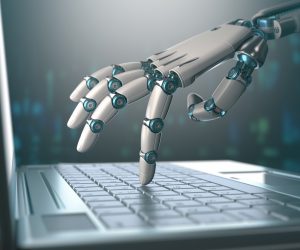Robotic Process Automation for the Daily Workflow
Robotic Process Automation for the Daily Workflow
 RPA or Robotic Process Automation is a rising technology that could have a huge impact in your organization.
RPA or Robotic Process Automation is a rising technology that could have a huge impact in your organization.
This technology has nothing to do with automating the factory floor but instead is focused on streamlining the mundane and predictable daily work that a knowledge worker does. In our current economy, where finding workers is always a challenge, using this technology to automate repetitive desktop computing tasks has a huge impact.
What is RPA?
RPA can best be described as a software robot that runs on your desktop. This robot learns about your daily tasks and can be used to automate these tasks at various levels. The more consistent the task, the more automatic the result. If the task requires human thought, it can stop and wait for input and then continue its path. Who doesn’t want a robot that helps them do their work?
Though this technology is not altogether new, it is emerging and changing rapidly. Different vendor products offer widely varying levels of functionality. At its most basic, RPA software is pretty simple. It operates like a macro and allows a software platform to interact with a database and look up information relevant to the current process.
At its next level, an active workflow can be instituted based on the active application, and it can interact with other programs directly to lookup or input information. As we work up the spectrum of software available, some of the more advanced software robots self-learn with human aid and even make limited decisions based on the information provided. The most advanced software has the ability to make multiple decisions based on multiple screens or applications, and vendors are scrambling to enhance and build true artificial intelligence.
Innovation Meets Efficiency
RPA technology has the most demonstrative impact in areas where repetitive processing is done by a group of workers. Because of this, many of the case studies are in Finance, Banking, and Insurance. In a study conducted for a highly-repetitive banking process, the bank applied RPA to automate a transaction review process. This process involved more than ten workers who reviewed transactions for insufficient funds, debit problems, and other payment issues. Once the RPA software robot was implemented, they were able to return 80% of those employees to a more customer-facing role.
The impact of RPA goes far beyond reducing the FTEs (full-time equivalents) dedicated to a function. It often makes the whole process more consistent and without error. It can also reduce the overall time to process, which may provide a competitive advantage over the competition and improve the customer experience. Often the person who was dedicated to the manual screen-based process is freed up to take on a more customer-facing role.
The following types of work are ideal for the application of RPA technology:
- Data is being entered and human error is common
- The process is well documented and known
- The task being considered is repetitive, making it easy to create rules
- There are significant worker resources being spent on this task
- A significant amount of time is being spent looking for information that is then captured or keyed
- Software is being used that is complex and entry requires multiple screens
- Data entry is duplicated in multiple software platforms
This technology may seem unrealistic or reserved for large organizations. However, many of these software tools have become mainstream and applicable for small and medium-sized businesses. One of our clients uses this type of technology to automate their process of updating multiple software systems.
Prior to the application of the RPA software, they had to evaluate and rekey information between systems. Now, as the worker is entering information into one system the software robot learns that information, allowing it to automatically key enter it into the other software application for that worker. This eliminates the possible errors of dual-entry and significantly reduces entry time.
The Future of RPA
RPA is often considered a contributing technology to the Fourth Industrial Revolution. The Fourth Industrial Revolution and the Second Machine Age both refer to the age of impact of technology across all disciplines, physical, digital, and biological. The Second Machine Age refers specifically to the effects of digitization and AI on the economy. RPA is maturing quickly and fits in these categories because of its impact on how people work and its developmental work in applying true AI to automating information work.
RPA is not without controversy as any software that is trying to make use of AI. There is a potential for it to learn a worker’s bad habits. Or it could learn your passwords and learn to make bank transfers. What if a hacker would gain control of a desktop robot? And, like any automation initiative, it reduces our reliance on human workers. There are hurdles to overcome and security checkpoints to consider. Its value though will quickly outweigh these concerns.
This technology is already innovative, and as software vendors rush to make their products even more autonomous and intelligent, it will continue to impact how we work daily. It will free workers to do higher-level work that requires cognitive skills. It will automate things that we previously thought were just part of being at work. Are you ready for that desktop robot to give you a hand?
Do you want to learn more about RPA and other future-focused technologies that could impact your business? Our specialized team at CTaccess can help you assess your current workflow performance and identify the best business process automation solutions for you and your team.

Scott Hirschfeld is the President of CTaccess, a Brookfield IT support company that has been helping businesses stop focusing on IT and getting back to doing business since 1990. Under his leadership CTaccess provides the business minded approach of larger IT companies with the personalized touch of the smaller ones. Connect with Scott on LinkedIn.
